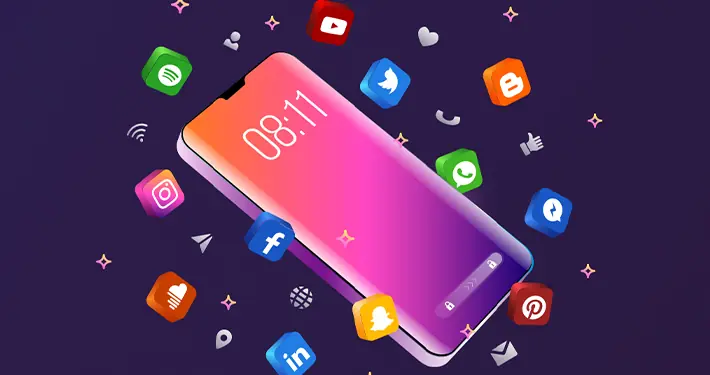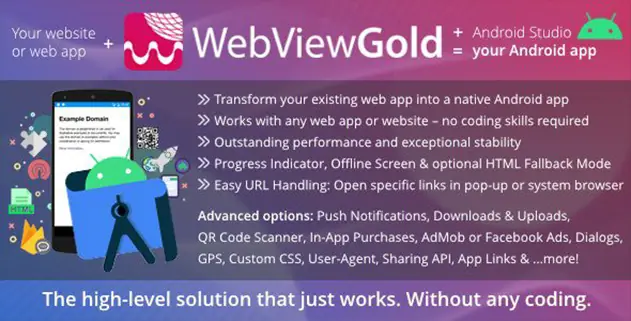WebViewGold for Android 12.3
WebViewGold Free is an innovative WebView app designed to make things easier for you: Create your own apps for Android with just a few clicks and without any understanding of code using this innovative WebView app template.

WebViewGold for Android 12.3 Features
- Full Android WebView App Template
- Works with any web app/website that works on Chrome browser
- Submit your app to the Google Play Store easily
- Optimized for exceptional performance
- Powered by the powerful Chromium web engine
- Easy: Just define your URL (or your local HTML folder) and WebViewGold takes care of the rest!
- Always up-to-date
- Optional fallback switch mode
- Native Loading Spinner/Android Activity Indicator while loading your URL
- Display a Splash Screen
- Smart Performance Cache Mechanism
- Offline Screen with “Try again” button if your app can’t connect to your URL
- HTML 5 Audio / HTML 5 Video Fullscreen / HTML Geolocation support
- URL Handling
- Custom Status Bar Background Color
- Language Detection: Append the user system language to the WebView URL
- HTML5 Live Audio Recording supported
- File Uploads & Camera Uploads supported
- Support for uploading multiple files in HTML upload forms
- Custom User-Agent supported
- Option to prevent the device from going to sleep mode while the app is active
- Image, PDF, ePub, Documents, and Music File Downloader API
- In-App Purchases & In-App Subscriptions API
- Native Sharing Dialog API
- UUID API
- Pull To Refresh Functionality
- Take Screenshot API
- App Version Check API
- Dynamic Status Bar Color API
- Social Login Support
- Swiping Navigation Functionality
- Optional Tab Functionality with additional In-App-Browser
- “Reset the app” API
- “First Run” Dialog
- “Rate my app” Dialog
- “Follow on Facebook” Dialog
- Custom Text Zoom Scaling Option
- Easy orientation settings
- Powerful QR Code Scanner API
- NFC (Near Field Communication) integration possible
- Push Notifications via JavaScript
- Option to append individual OneSignal/Firebase push user IDs to the web page URL to assign unique push tokens to the user on the server side
- OneSignal In-App Messages Support
- Support for WalletConnect scheme
- Banner & Full-Screen Interstitial Ads by AdMob or Facebook Audience Network can be activated
- Advertising ID Support
- Screenshot Prevention Option
- Auto-Refresh Option
What is a Mobile App
A mobile app, or mobile application, is a specialized type of software created for mobile devices, such as smartphones and tablet computers. In contrast to conventional desktop or laptop applications, mobile apps are tailored to leverage the unprecedented reach, portability, touchscreen interfaces, and diverse functionalities of mobile platforms.
Mobile apps fall into three main categories: hybrid, native, and web apps. A native app is a software application developed specifically for one mobile device operating system (OS), while a native and web application can each run on more than one OS.
The Apple App Store was pivotal in popularizing mobile applications, offering a vast array for iPhone, iPad, and iPod Touch users. Now, Google Play Store has overtaken the App Store in terms of the number of available apps. These app stores are home to the world’s iOS and Android apps.

Examples of mobile apps include gaming apps that entertain, productivity apps that make tracking and accomplishing work easier, ecommerce applications, and health-tracking apps to maintain people’s mental and physical well-being.
Users are not the only ones who benefit from applications. More businesses and organizations are building mobile apps to generate more income or scale their operations. These entities develop apps independently, scout for outsourced talent, hire freelancers, or collaborate with app agencies to succeed in their goals.
One key industry that leverages mobile apps for growth is e-commerce. There are many examples of ecommerce companies that have gone mobile. One relevant instance is when MyDeal collaborated with Appetiser Apps to maintain industry competitiveness in the face of user migration from desktops to smartphones.

